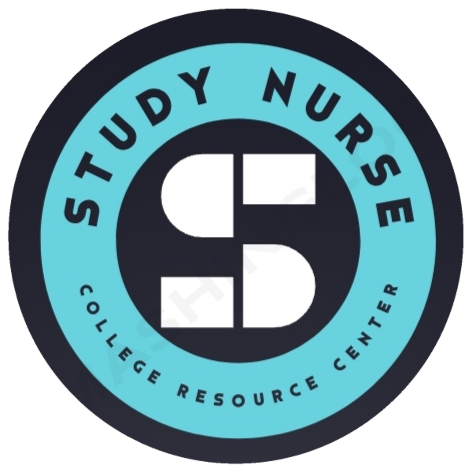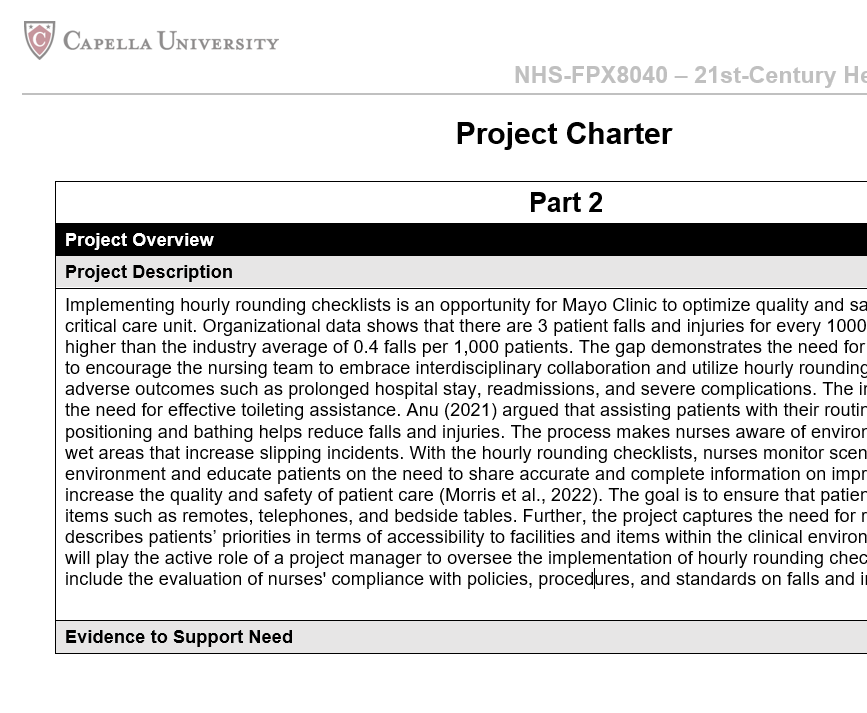Project Charter
Part 2
Project Overview
Project Description
Implementing hourly rounding checklists is an opportunity for Mayo Clinic to optimize quality and safety outcomes in the critical care unit. Organizational data shows that there are 3 patient falls and injuries for every 1000 patients. The rate is higher than the industry average of 0.4 falls per 1,000 patients. The gap demonstrates the need for proactive interventions to encourage the nursing team to embrace interdisciplinary collaboration and utilize hourly rounding checklists to reduce adverse outcomes such as prolonged hospital stay, readmissions, and severe complications.
The intervention aligns with the need for effective toileting assistance. Anu (2021) argued that assisting patients with their routine needs such as bed positioning and bathing helps reduce falls and injuries. The process makes nurses aware of environmental aspects such as wet areas that increase slipping incidents. With the hourly rounding checklists, nurses monitor scenarios within the care environment and educate patients on the need to share accurate and complete information on improvements required to increase the quality and safety of patient care (Morris et al., 2022). The goal is to ensure that patients have easier access to items such as remotes, telephones, and bedside tables. Further, the project captures the need for ranked lists that describes patients’ priorities in terms of accessibility to facilities and items within the clinical environment. The DNP student will play the active role of a project manager to oversee the implementation of hourly rounding checklists. The process will include the evaluation of nurses’ compliance with policies, procedures, and standards on falls and injury prevention.
Evidence to Support Need
Patient falls and injuries are a serious concern in critical care units. Patients are vulnerable to readmissions, prolonged hospitalization, and increased cost of care. Increasing safety incidents at Mayo Clinic call for proactive and sustainable interventions. Hourly rounding checklists are among the viable options available to enhance environmental risk assessments. The checklists enable the nursing team to capture quality and safety scores based on a ranked list of items associated with falls and injuries (LeLaurin & Shorr, 2019). Hourly rounding checklists help organizations balance falls prevention with patient priorities such as accessibility to toileting and other items. Further, hourly rounding checklists encourage interdisciplinary practices where nurses, physicians, pharmacists, physical therapists, occupational therapists, patients, and families collaborate to identify risks and prevent falls (LeLaurin & Shorr, 2019). Embracing scheduled rounding protocols helps Mayo Clinic tailor interventions to match events in the critical care unit. Hourly safety checklists allow nurses to familiarize themselves with the clinical environment, improve call light use, maintain possessions within reach, and maintain proper bed positioning.
Project Purpose/Business Case
Implementing hourly rounding checklists allows the care team to initiate improvements that align with Mayo Clinic’s quality and safety priorities. Similarly, there are opportunities to act in the best interests of vulnerable patients and their families. The priority is the acute care setting where patients come to the facility because they are confident of a successful and timely recovery. Thus, the hospital will prevent emotional, physical, mental, and financial distress to patients, healthcare professionals, and the organization (Walsh et al., 2018). Hourly rounding checklists demonstrate the hospital’s goal of keeping falls and injuries as low as possible by balancing multiple priorities such as interdisciplinary collaboration.
SMART Objectives (Specific, Measurable, Attainable, Relevant, Time-Sensitive)
• Reduce patient falls and injuries by 20% by the fourth week of the implementation period.
• Enhance nurse compliance with patient handling practices by 30% by the sixth week of the implementation phase.
• Reduce falls-related prolonged hospitalization by 100% within six months.
Project Scope
The project team will initiate a pathway for implementing hourly rounding checklists. The process helps members capture hazards and risks within the clinical environment associated with falls and injuries. An interdisciplinary approach promotes shared governance to make informed conclusions on weaknesses that undermine organizational commitment to optimizing safety and quality outcomes.
Project Deliverables and Milestones
The implementation will take place in six weeks. The duration allows the project team to design, test, and adopt hourly rounding checklists. Approval of the project will happen in August. The next phase is data collection and evaluation which will happen in two weeks to enable the team to understand trends in patient falls and injuries. Analysis and compiling of data will produce a report with details about the impact of hourly rounding checklists on patients, healthcare professionals, and the organization. Meaningful milestones are achievable through accurate and complete analysis of administrative, human, and technical aspects associated with falls and injuries.
References
Anu, J. (2021). Hourly rounding and fall prevention among the elderly in long term care: A change Process. Journal of Geriatric Medicine, 3(1), 1-4. https://ojs.bilpublishing.com/index.php/jgm/article/download/2614/2742
LeLaurin, J., & Shorr, R. (2019). Preventing falls in hospitalized patients: State of the science. Clinics in Geriatric Medicine, 35(2), 273-283. https://www.ncbi.nlm.nih.gov/pmc/articles/PMC6446937/
Morris, M., Webster, K., Jones, C., Hill, A., Haines, T., McPhail, S., Slade, S., Heng, H., Shorr, R., Carey, L., Barker, A., & Cameron, I. (2022). Interventions to reduce falls in hospitals: A systematic review and meta-analysis. Age and Ageing, 51(5), 1-11. https://academic.oup.com/ageing/article/51/5/afac077/6581612
Walsh, C., Liang, L., Grogan, T., Coles, C., McNair, N., & Nuckols, T. (2018). Temporal trends in fall rates with the implementation of a multifaceted fall prevention program: Persistence pays off. The Joint Commission Journal on Quality and Patient Safety, 44(2), 75-83. https://www.ncbi.nlm.nih.gov/pmc/articles/PMC6736680/

